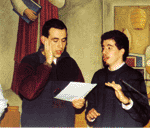The little choir of the Gregorianum
Singing in a choir is an experience which well fits in any community and often becomes a happy celebration. Since the beginning, in our little family, groups of students spontaneously gathered to sing together. On one hand enlivening the liturgy and on the other celebrating degrees represent privileged places for such an activity. The never-interrupted tradition of teaching the Gaudeamus to freshmen as soon as they are admitted to the college and to proudly sing it during community get-togethers, characterizes those of the Gregorianum. Many times this hymn echoed in the mountain refuges and every time, to the astonishment of tourists, small groups of foreign mountain lovers joined us. In the 90s, however, in different moments two initiatives with a more organized nature arose, and this brought to the joy of singing the fatigue of studying and tests, as witnessed by the maestros Collarile and Schivo.
Moments of a singing adventure. The choir in the college from 1992 to 1996
I clearly remember Dr. Granello's grin when I told him that I would have brought the choir of the college back to life. A mythical institution, whose past glory much was fabled, and just for this merited to be reborn. Which were its goals was up to me to decide; and as a student of the conservatory (as well as being a student of letters) these goals could not but be the most serious and rigorous sacred polyphony, besides, obviously, the Gregorian chant.
The renaissance querelle between "stile antiquo" and "stile moderno" is nothing compared to the everlasting dispute that arose in the small wilful group of Gregorians, only apparently interested in dedicating themselves to the sublime art of the XVI century contrappunto. The general reaction to my first proposal (a mottetto by Orlando Di Lasso) was not one of the best. If "the price to pay for sacrificing an after dinner was this, they told me, the "small choir" would not have gone very far. I hoped to the last in the support of the few exponents who still boldly defended classical music in the college: but, alas, even among these there were not many who wanted to dedicate themselves to singing. And so, the algebraic speculations with Marchesini on the subdivision of tempered semitone, the metaphysical ones with Mendola and Rouge on the polyphonic architecture in Bach's composition, or again Guerra's never-ending exercises on the violin, didn't help me to lead the choir on the road to a serious polyphonic commitment. I could clearly identify at least two trends: those of the mountains who belonged to the old guard, especially for the ones coming from the Vicentino-Veronese-Bellunese axis made up of Massenz, Rinaldo, Cume and warmly sponsored by Beppe; and a "modernist", much more insidious, which acted transversally and who found the vital lymph in a small group of young freshmen (Borgo & company).
What was happening in the choir was just the tip of an iceberg: what really mattered here was the music which would have been played during the liturgies here at the Gregorianum each Wednesday evening. Since an organ suddenly appeared in the college chapel, the resort to a repertory of hymns accompanied by guitars had undergone a drastic limitation. If we then consider that the organ had entered the college many years before the first computers, it's easy to picture the atmosphere around the new liturgical instrument, according to some a real operation of musical obscurantism. The theorem "Tu fonte viva" cost me a terrible trial, in which nothing availed the defences of the already affirmed attorney Gianni Gozzi. I never doubted that the real problem was essentially of a theological, more than aesthetic, nature: why in heaven should we have sung such a protestant chorale? Yet the doubt still remains, because even to the most orthodox polyphony my fellows seemed to be riotous.
Going on by concession, "me compare Giacometo" became the hit of a group whose highest aspiration was singing aloud in some mountain refuge or during the annual college feast (especially awaited were the congratulations made by the kitchen staff). Thanks to the harmony of some exponents, either for singing gifts (how can we not remember Cume and the Kobra, two of our golden voices! Cucco, Rinaldo, Dino, Vittorio, Stiz, Bastianello, Montin, Fasoli, Bortolan, Tuzza and all the others who only every now and then participated in the rehearsals because overburdened with studies, please don't hate me), either for serious musical interests (Beppe's and mine in primis), we were even able to achieve some result worthy of mention. Even if fewer than usual, thanks to an improvised extemporary concert at 2 in the morning and the porticos of the Servants of Maria, received an unconditional applause not only from all the neighbours but even from the local police. But we reached the apex of our success with the recordings held in the theatre of Schio. One after the other, we recorded the songs of our first album: "Se 'l mare fosse de tocio, olalilala, e le montagne polenta, olalilala...", "Son pien de peo, son pien de peo..." and many other goliardic successes which had always accompanied degrees in Padua taken by Gregorians. So, after this fatigue, accompanied by the best student representative (Big Alberto who was still a student) we pointed toward the hills for an unforgettable dinner of bigoli. In loving memory of this commitment I still preserve an audio tape which witnesses the vocal vertices reached by those who at the time studied at the Gregorianum.
In the generational change, the "modernist" soul seems to have overcome even the mountain style. "O tempora, o mores", Codognotto would exclaim, calling to mind his Farinelli past: but this is recent history and it needs be told by those who saw and sang it.
Luigi Collarile
Student at the Gregorianum from 1991 to 1998
(Translated by Stefano Capuzzo, Simone Zancanaro - 2009)
Intro > Students
